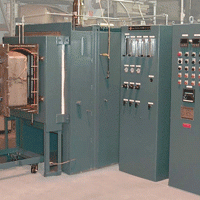Cold wall vacuum furnaces dominate the vacuum furnace industry and are available in a variety of sizes and workload configurations. In comparison to hot wall furnace designs in which the process is run inside a vacuum-tight retort, the cold wall design runs the process inside a sealed vacuum vessel. As such, the furnace shell must not only be suitable for vacuum service but for operation at positive pressure.
Before 1960, metallurgical heat-treatment processes in vacuum equipment were limited to specialized applications and relatively simple processes such as the annealing of copper wire. The introduction of industrial cold-wall furnaces increased the number of applications considerably because of the possibility to quench the charge by forced gas circulation (at pressures slightly below atmospheric). By the early 1970’s, cold-wall furnaces with oil quenching capability were introduced and by the mid-1980’s high-pressure gas quenching designs became available. Since the 1980’s the quench pressures have steadily advanced, from sub-atmospheric to as high as 25 bar, with 5 and 6 bar, 10 bar, and 20 bar dominating the industry.






